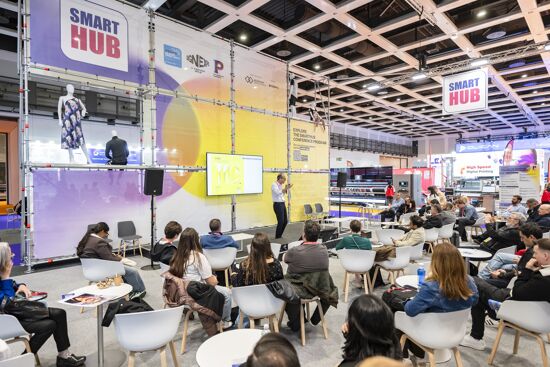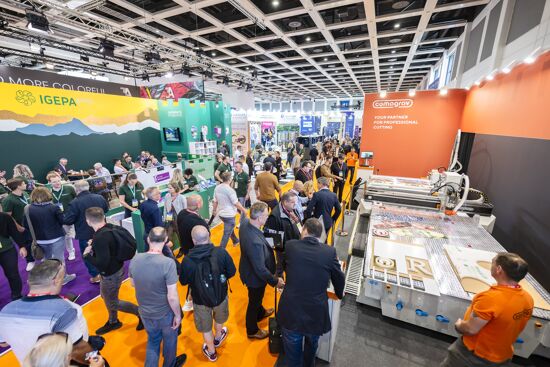Tested: Vutek QS3 Pro
Both high print speed and photographic image quality are essential to today’s large format printers, especially the UV-curable models. The Vutek QS3 Pro printer from EFI is designed to meet such demands. The QS3 Pro offers a larger output format, up to 3.2m, than the QS2 Pro, which is a 2m wide printer.<br><br>
In terms of technical specifications, the Vutek QS3 Pro offers variable droplet greyscale printing head technology with a maximum resolution equivalent to 1000 dpi. It uses variable sized ink droplets, between 0-36 pL and has a maximum production speed of 111 m2/h at the equivalent of 600 dpi print mode.
The six base colour ink set is complemented with white and you can print up to three layers of white inline. It is a hybrid printer, since it handles both rigid and flexible roll-to-roll media, up to 3.2m wide and up to 5.08 cm thickness.
Typical production is displays, banners and POP materials, both for indoor and outdoor use.
The QS3 Pro can be controlled through a number of RIPs, but EFI offers a tightly integrated version of the Fiery XF RIP as the main choice. It’s possible to print multiple jobs at once, and the system can be integrated with MIS and W2P solutions.
How the test was done
Our test requires the participant to provide output samples from test files supplied by Digital Dots. For the colour gamut test, we use a standard IT-8 CMYK profiling chart; for the resolution test, we use a specially designed chart with line pairs at a wide range of spacing. The participant prints these under optimum conditions onto the two types of substrates, glossy vinyl and uncoated paper. In the test a QS2 Pro was used, but it shares the same technical specifications as the QS3 Pro, except for the maximum printing width.
For visual evaluation of general image quality and smooth reproduction of tonal graduation, we also asked for an output of a poster size 70x100cm. This poster was also used to evaluate the uniformity of ink density across the whole width of the substrate. We take five measurements of full tone cyan and then use the SpectroShop software to compare the colour deviation between the first sample and the other four. As a threshold we decided on 2.5 ∆E, the same value suggested in the ISO 12647-2 standard for when printing solid spot colours.
We measure colour gamut by creating a standard CMYK ICC profile from the IT-8 colour chart data. This was done using an X-Rite i1 Pro spectrophotometer and professional profiling software. The profile was then analysed with Chromix ColorThink Pro to yield a figure for the total number of discrete colours contained within the gamut. We define discrete colours as separated by a delta-E value of 1, using the CIELab colour space as reference.
Fig 1. In the resolution test the QS3 Pro showed identifiable line pairs up to the equivalent of 250 dpi, both in the horizontal and vertical direction. Here an image of the sample as seen using a digital microscope at about 500x enlargement.
To measure resolution we viewed the prints of the line pairs chart under a digital microscope. We wanted to determine the point at which the lines could no longer be differentiated as distinct pairs.
We call this the resolving power of the printing system, and this is often different than the stated addressable resolution, as per the technical specification. The resolving power is a combination of the native resolution of the print heads, droplet size and mechanical precision when moving the print heads and/or media while printing. As a complement to the line pair chart we also print text, both positive black on white and inversed white on black, in a small font (down to 4p).
Results in numbers
EFI submitted test samples produced using the CMYK plus light versions of cyan and magenta, at 1000 dpi mode on 3M FS40 glossy vinyl with the ‘heavy smoothing’ option selected. Our gamut test indicated a total of around 324,000 colours, which is a bit lower than the approximately 400,000 colours when using offset print technology on coated stock). For the uncoated substrate, printed on Ilford paper, the gamut was measured to be slightly lower still, 315,000 colours. But this was expected, since prints on uncoated stock normally produce a less vivid and less colourful result than those printed on coated glossy stock.
Fig 2. The QS3 Pro could reproduce small text of 4pt size, especially as black on a white background. The inversed white text on black background was a bit thin, but still visible. Here, an image of the sample as seen using a digital microscope at about 500x enlargement.
In the resolution test, which was printed on the same 3M FS40 glossy vinyl and with the same resolution settings as the colour gamut chart, distinct line pairs could be seen at up to 250 dpi in both the horizontal and vertical direction. The output should ideally be printed in black only, but we could still judge the resolving power by focussing on the black part of the output.
The small text was clearly reproduced down to 4pt, especially the positive text in black on white. The inversed text with white on black background was a bit thin, with the black area swelling into the white text, but still clearly visible.
Fig 3. When measuring all five samples of full tone Cyan across the width of a 70x100 cm poster, the uniformity of the ink density was good. We use the threshold of 2.5 ΔE, as suggested in the ISO 12647-2 standard, as when printing solid spot colours. Any colour deviation lower than 1 ΔE is invisible for the human eye to detect. The first sample is compared with itself, so will give a zero colour deviation.
Regarding uniformity, the QS3 Pro showed a maximum deviation across the page of 1.5 ∆E (and in average 1.1 ∆E), which has to be seen as very good. By comparison a colour deviation of 1∆E is impossible for the human vision to detect.
Technical specifications - Summary
Vendor: EFI
Model: VUTEk QS3 Pro
No. of Inks: 6+1 + white
Ink Set: CMYKcm
Max Media Size: 3.2m
Max Media Thickness: 5.08cm
Resolution (dpi): 1000dpi
Print Speed: 111 m2/h*
Conclusions
The VUTEk QS3 Pro has high image quality and can print on a large variety of substrates, so for companies that don’t need the speed of more costly printing systems this should be a suitable printer for many applications.
Editor's note: This product test was first published in the September 2013 edition of Spindrift, published by Digital Dots. Spindrift, the leading industry newsletter for innovation and sustainability, is available for €25 per issue, or free as part of membership of any FESPA affiliated national assocation. If you are a member, please log in to get access.
Topics
Interested in joining our community?
Enquire today about joining your local FESPA Association or FESPA Direct
Recent news

Industry Experts Explore the Evolution of Smart Manufacturing in the Textile Industry
A FESPA SmartHUB roundtable at Personalisation Experience 2025 discussed smart manufacturing's transformative impact on the textile industry. Experts highlighted the shift to on-demand customisation, driven by digital printing, data analytics, and automation. Key takeaways included enhanced machine control, significant waste reduction through intelligent software and colour management, and improved sustainability via energy efficiency and near-shoring, ensuring agility and environmental responsibility in textile production.

FESPA 2025 gathers leading visionaries from across the speciality print industry in Berlin
FESPA Global Print Expo 2025, European Sign Expo and Personalisation Experience (6 – 9 May 2025, Messe Berlin, Germany) welcomed Visionaries from across the speciality print industry to shape the future of print, develop forward-thinking business strategies, and explore innovative ways to translate emerging industry trends into tangible growth opportunities.

Exploring Cutting-Edge Textile Printing Innovation with Adobe Print Engine 7
Adobe PDF Print Engine 7, launched at FESPA Global Print 2025, significantly advances textile printing. Debbie McKeegan shares how it automates non-white substrate management and RGB colour handling, expands colour gamuts with in-RIP multicolour transparency blending, and streamlines workflows for efficiency and sustainability. This update boosts customisation, reduces waste, and positions businesses at the forefront of digital print innovation.

FESPA Global Print Expo 2025 - Overall Highlights
FESPA Global Print Expo, Europe's leading print and signage exhibition returned to Messe Berlin from 6 - 9 May 2025.